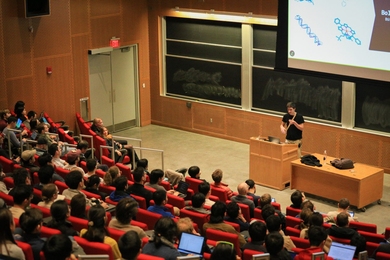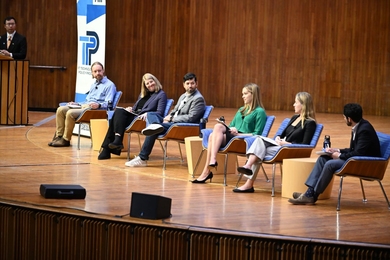Women last year were at least half the number of undergraduates majoring in nine departments of the schools of engineering, science, architecture and planning, and humanities and social sciences.
The departments which were predominantly women and had the most women were chemical engineering, biology, civil/environmental engineering, chemistry, architecture, brain and cognitive science, humanities, urban studies and planning, and linguistics and philosophy, according to data from the Registrar's Office.
MIT's most popular course, electrical engineering and computer science (Course 6), drew the highest number of women at 177, but its percentage of women as majors was the lowest at 18 percent. The fourth most popular course among women was mechanical engineering (Course 2), which last year drew 111 women majors (24 percent of all ME majors).
Thirty-four percent of all sophomores, juniors and seniors were women (1,160 women among 3,428 students). A total of 15 departments involving all five schools had more than 43 percent women.
Chemical engineering (Course 10), which since 1987 has been the most popular course dominated by women, last year had 155 women comprising 51 percent of its majors. Biology (Course 7) was next, with 147 women (51 percent of the students). Next was civil and environmental engineering (Course 1), with 70 women (55 percent), followed by chemistry (Course 5) with 59 women (53 percent); architecture (Course 4) with 48 women (56 percent); brain and cognitive science (Course 9) with 28 women (55 percent); humanities (Course 21) with 23 women (52 percent); urban studies and planning (Course 11) with 8 women (50 percent), and linguistics and philosophy (Course 24), with one woman as its sole undergraduate student (100 percent).
Materials science and engineering, which since 1987 has often had a majority of women, last year attracted 60 women (47 percent of the total). Other departments with less than half-but a higher than average proportion-of women majors were nuclear engineering (Course 22), 16 women (48 percent); materials science and engineering (Course 3), 60 women (47 percent); political science (Course 17), 12 women (46 percent); earth, atmospheric and planetary science (Course 12), 7 women (44 percent); management (Course 15), 39 women (43 percent); and economics (Course 14), 32 percent (43 percent).
Besides EECS and mechanical engineering, the other departments with a lower-than-average proportion of women majors were aeronautics and astronautics (Course 16), 43 women (31 percent); mathematics (Course 18), 55 women (31 percent); ocean engineering (Course 13), two women (22 percent); and physics (Course 8), 40 women (20 percent).
The total for women majors by schools was as follows last year:
School of Engineering, 634 women majors constituting 29 percent of all majors.
School of Science, 336 women majors, 40 percent.
School of Humanities and Social Sciences, 68 women, 47 percent.
School of Architecture, 56 women, 55 percent.
School of Management, 39 women, 43 percent.
A version of this article appeared in the September 28, 1994 issue of MIT Tech Talk (Volume 39, Number 6).





